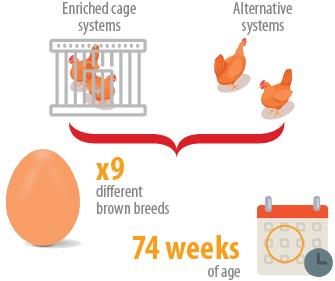Reproduction and genetics
Optimizing saleable eggs: Efficiency & Profitability of layers.
To read more content about aviNews España Diciembre 2019 ENG
Reproduction and genetics
To read more content about aviNews España Diciembre 2019 ENG
Content available at:
Español (Spanish)
When evaluating a layer flock’s performance, certain parameters are used in order to establish a minimum threshold of quality. The most common parameters include: Feed conversion, export of egg mass and number of eggs per housed hen (HH). Nowadays, other criteria are gaining relevance, such as SALEABLE EGGS per housed hen, as well as its COMMERCIAL VALUE by weight, be it from cage or alternative systems.
If we were to measure efficiency & profitability of layers according to the classic model, the metrics would be:
Today, it is assumed that most genetic lines have been able to optimize these metrics to be on the market.
In this article, we are going to evaluate layer performance, based on profitability obtained per HH, and referenced to two fundamental ratios:
No. of saleable eggs
The idea here is to not only to maximize the number of eggs produced per HH, but maximizing the number of eggs for which we obtain the highest market profitability. That is why the % cracked eggs, quality and shell color take the greatest relevance.
Distribution of egg mass in different calibers and weights, continues to be a fundamental parameter to maximize the commercial value of our productions.
In addition to having an optimal feed conversion, it is about maximizing the income of our production, through optimizing the commercial value of said production
We must note that the market demands for layers that are flexible enough that their genetic potential can be maximized in both cage and alternative systems. They must be high yielding birds regardless of the system, since neither genetic selection nor multiplication can work simultaneously with many lines of birds efficiently and profitably.

How to measure efficiency and profitability of hen breeds?
In order to answer that question, we are going to analyze data and parameters in the XVI International Random Sample Test in Ustrasice, (Czech Republic, 2018), where data from 9 genetic lines of brown egg breeds have been recorded, up to week 74 of life in both enriched cage and alternative systems.
The parameters that were compared include:
Saleable eggs
Inevitably, the number of saleable eggs has a very high correlation with the number of total eggs produced and with the percentage of cracked eggs, and therefore, their combination. As we can see in the graph, sometimes birds with the highest number of total eggs produced do not report the highest level of income, since a large part of them are not saleable, a circumstance that is more evident in alternative systems.